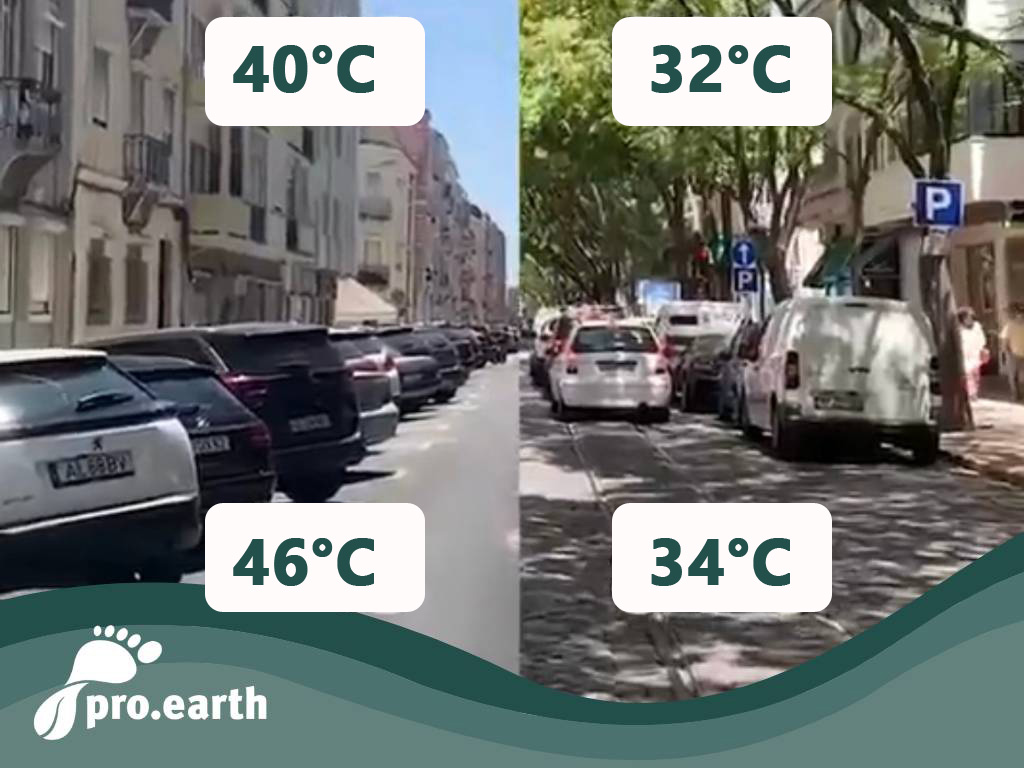Combating heat in urban areas

One heatwave after another is rolling across Europe. Southern and eastern Europe have been particularly hard hit this year. But even in Central Europe we have reached over 40 degrees Celsius. Climate change is increasing the number of tropical days and nights. And our cities are particularly hard hit. The heat builds up here and it cools down less at night. Scientists call this effect the "heat island effect". According to the German Federal Environment Agency, the difference between the night-time temperature in rural areas and in cities is already up to 10 degrees.
Why do cities heat up so much more
The reasons for this are manifold:
-
- For example, floors sealed with concrete and asphalt absorb solar radiation and transfer the heat to deeper layers.
- In addition, less vegetation in cities means that less water evaporates, which cools the air.
- Buildings also contribute to the heat island by increasing the surface area of the city in which heat is stored and by reducing air exchange.
- The many roof surfaces also contribute to this
- Also exhaust fumes from traffic and industry
- And heating and cooling also increase the heat even further
- Parked cars also provide more heat
The use of trees
The idea is well known. Trees cool the environment immediately and are the most important factor in the fight against heat.Scientists have shown that trees can reduce air temperatures by upto 5 degrees Celsius and cool surfaces by up to 25 degrees Celsius by providing shade. According to a Lancet study, up to 40% of heat-related deaths could be avoided if 30 percent of urban areas were shaded.
Creating more green spaces with more trees is an essential aspect of cooling our cities. However, these must be planted in such a way that they can reach a respectable age and do not have to be cut down again after 15-20 years, as is common practice in many places today.
This works with the sponge city principle for trees. The subsoil is shaped in such a way that the trees can develop a vital root system and are supplied with sufficient water.
Trees are real all-rounders. They provide shade, filter fine dust, bind CO2, evaporate water, maintain biodiversity, create a pleasant atmosphere ... and cool. Nut trees, for example, are very suitable, as are fruit trees, which are currently hardly used at all.
There is a rule of thumb: one hectare of park cools the environment by one degree.
There are also options for greening façades and roofs and creating cooling islands of green pergolas in squares.
Further climate change adaptation measures
Magdalena Holzer from Weatherpark, an engineering firm specializing in urban climatology, is convinced that "climate change adaptation in cities will become increasingly important in the coming years". However, she believes that there is no general solution: "What is important is a suitable mix, which can vary depending on the location." This includes, among other things
-
- Water areas such as small lakes and streams (also known as blue infrastructure)
- Drinking fountains and other water supply points
- Allowing fresh air corridors into the city and not obstructing them
- Few sealed surfaces so that evaporation remains possible and surface water can seep directly into the ground when it rains - sponge principle
- Use of light building colors and roof tiles. For example, an invention from the USA - the "whitest white", which reflects 98 percent of light and lowers the temperature on surfaces by four degrees.
- Enough space for alternative means of transportation instead of cars
- Shading of walkways, for example with awnings and canopies
- Use of other surface materials such as granite instead of asphalt
How well equipped are the cities?
Many experts agree. Germany and Austria have not yet planned sufficiently in terms of heat protection for cities and therefore have some catching up to do.
"Climate adaptation in cities is underway, but progress is slow. As cities and buildings are often planned for decades or even centuries, it is naturally difficult to bring about changes quickly in existing cities. In contrast, there is room for maneuver when planning new buildings, new development areas - especially on brownfield sites in the inner areas of cities - and new cities. Here, measures can be implemented in just a few years." says, for example, Prof. Dr. Stefan Emeis, retired, from the Institute for Meteorology and Climate Research (IMK-IFU), Karlsruhe Institute of Technology (KIT), Garmisch-Partenkirchen.






